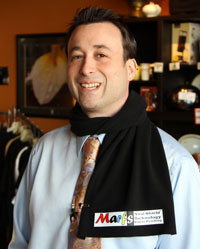It's a mask, it's a scarf, it's a MARF!
It's a mask, it's a scarf, it's a MARF!

In a classic case of necessity mothering invention, a Rowan University MBA student is marketing a hybrid mask/scarf he says will not only keep the wearer warm but protect him or her from cold germs.
Rob Hess, a Rowan computer science grad and budding entrepreneur, said the fleece-like material his MARFs are made from is impregnated with two germ-fighting systems - an antibacterial/antiviral silver treatment and an active carbon filter.
"The combination of the two produces beneficial ions that zap germs," said Hess, 35, of Glassboro. "It's the same combination used in air purifiers."
Hess, who travels frequently for business, said inspiration for the product came from coughing, sneezing fellow passengers during recent cold and flu outbreaks.
"I thought there has to be a way of protecting yourself without wearing a mask," he said. "The question was how can we provide better protection than a mask with a product people will actually use."
The answer is a scarf - make that a MARF.
"If you're on an airplane and someone next to you starts sneezing, just put the MARF to your face for a few minutes until the sneezing stops and consider yourself protected," he said.
How it works
Hess said the technology on which his product is based is not new, and the theory behind it - the production of beneficial negative ions - goes back eons.
He said testing conducted by two independent laboratories confirmed the anti-bacterial, anti-viral nature of the material and that it won't wash out.
"Our trap and zap technology does not kill viruses but inactivates them," Hess said. "It disrupts a protein that causes infection. It is a bold claim but that is the concept behind the MARF."
Edward Jones, COO of Hangersterfer's Laboraties in Mantua, one of the facilities that tested the product, said experiments confirmed claims that the material will block the transmission of bodily fluids - a prime factor in cold and flu transmission.
He said while the lab did not test specifically for elemental silver and carbon filtering, he noted that materials containing those properties are widely available and that apparel makers, especially in Asia, are increasingly weaving them into garments.
"The material was first used in the U.S. in hunting apparel," Jones said. "The idea there is that you don't give off a scent to the animals. In Asia it's much more common, in everything from socks to work-out wear."
Hess, who is in the early stages of his MBA work in entrepreneurship, said the business plan required for completing the program will revolve around the MARF and how he has marketed it.
To date that has mostly been online but at least one of his professors believes his idea has great potential.
"This is a unique combination of existing technologies that provides a completely new product, service or value," said Dr. Darren Nicholson, an assistant professor of MIS within Rowan's Rohrer College of Business. "The product is novel but the pieces and parts of it are not brand new. For me it's less about the product than the process, how he went about visualizing this product to provide value."
Hess said a Rowan discount of two for the price of one ($49.50) is available on his Web site. For more information, visit www.marfs.com.
